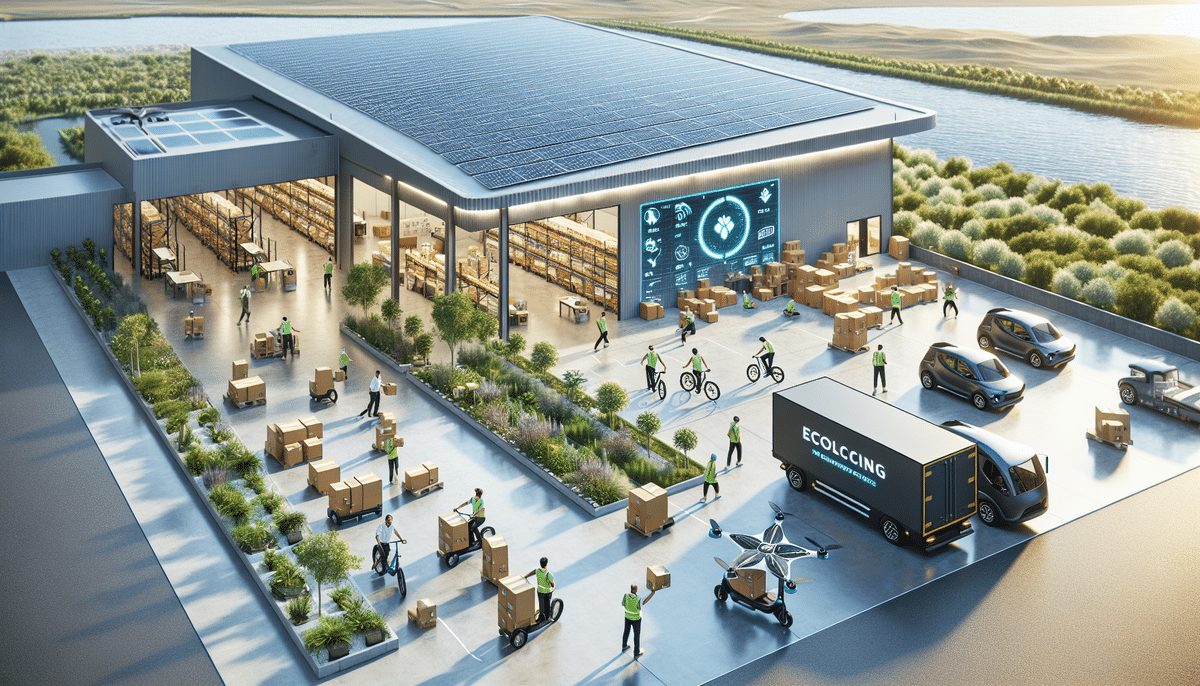Understanding the Environmental Impact of Ecommerce
The exponential growth of ecommerce has significantly intensified its environmental footprint. Transportation stands out as a major contributor, with product shipping generating substantial greenhouse gas emissions. According to the Environmental Protection Agency, the transportation sector accounts for approximately 29% of total U.S. greenhouse gas emissions.
The demand for faster delivery times has exacerbated this issue, leading to increased flights and higher emissions. Additionally, the production and disposal of packaging materials contribute significantly to environmental degradation.
It is imperative for ecommerce brands to acknowledge and address their environmental impact. Ignoring sustainability can result in a loss of customers and revenue, as consumers increasingly prioritize eco-friendly practices. Implementing sustainable packaging, such as using biodegradable or recyclable materials, reducing packaging volume, and adopting closed-loop systems, can substantially mitigate these impacts. Furthermore, embracing alternative transportation methods like electric vehicles or bicycles for last-mile delivery can enhance brand appeal among environmentally conscious consumers.
Strategic Role of Ecommerce Brands in Sustainability
Ecommerce brands are uniquely positioned to spearhead sustainability initiatives. By adopting sustainable practices, these companies can lessen their environmental impact and set a precedent for other industries.
Reducing the carbon footprint is a pivotal step. This can be achieved by integrating alternative transportation modes, optimizing shipping routes to minimize emissions, and collaborating with suppliers who prioritize sustainable sourcing and eco-friendly production methods.
Moreover, ecommerce brands can influence consumer behavior by offering sustainable products. This includes items made from recycled materials, biodegradable or compostable products, and goods designed for reuse or repurposing. Such offerings not only promote sustainability but also empower consumers to make environmentally responsible choices.
Effective Strategies to Minimize Carbon Footprint
Minimizing the carbon footprint involves a multifaceted approach:
- Optimizing Shipping Processes: Utilizing algorithms to determine the most efficient delivery routes and partnering with logistics providers to consolidate shipments can significantly reduce emissions.
- Adopting Eco-Friendly Transportation: Transitioning to electric or hybrid delivery vehicles and investing in renewable energy sources for operations can lower carbon output.
- Reducing Energy Consumption: Implementing energy-efficient lighting and heating systems in warehouses, monitoring energy usage, and investing in renewable energy installations like solar panels are effective strategies.
- Minimizing Packaging Waste: Using biodegradable or recyclable materials, optimizing packaging sizes, and encouraging customers to recycle through clear instructions and incentives can reduce waste.
- Sustainable Supply Chain Practices: Sourcing materials from sustainable suppliers, reducing water usage, and minimizing waste in production processes contribute to a holistic sustainability strategy.
According to a McKinsey report, companies that invest in sustainable practices can see a reduction in operational costs and an increase in long-term profitability.
Advantages of Adopting Sustainable Practices
Adopting sustainable practices offers numerous benefits:
- Cost Savings: Optimizing shipping processes and reducing energy consumption can lead to significant financial savings.
- Enhanced Brand Reputation: Transparently promoting sustainability initiatives fosters trust and loyalty among environmentally conscious consumers.
- Regulatory Compliance: Staying ahead of environmental regulations helps avoid fines and legal challenges.
- Customer Attraction: Sustainability attracts a growing segment of consumers who prioritize eco-friendly brands.
Research indicates that companies embracing sustainability experience increased customer retention rates due to enhanced brand loyalty.
Best Practices for Sustainable Packaging and Shipping
Effective sustainable packaging and shipping are critical areas for ecommerce brands:
- Eco-Friendly Materials: Utilize biodegradable or recyclable packaging materials to reduce environmental impact.
- Optimized Packaging: Use appropriately sized packaging to minimize material usage and shipping costs.
- Recycled Fillers: Incorporate fillers made from recycled materials to enhance sustainability.
- Partnering with Sustainable Carriers: Collaborate with logistics partners committed to eco-friendly transportation methods.
- Minimal Packaging: Adopt minimalistic packaging designs to reduce waste.
- Reusable Packaging: Offer packaging that customers can reuse for other purposes.
- Take-Back Programs: Implement programs allowing customers to return packaging for reuse or recycling.
Implementing these practices not only diminishes environmental impact but also reduces shipping costs. According to a study by GreenBiz, optimized packaging can lead to a 15% reduction in shipping expenses.
Engaging Customers in Sustainable Shopping Habits
Educating customers is paramount in fostering sustainable shopping habits:
- Transparency: Provide detailed information on the environmental impact of products to inform consumer choices.
- Resources: Offer recycling programs and guidelines on proper product disposal.
- Eco-Friendly Options: Promote alternative, sustainable products to encourage environmentally responsible purchases.
- Engagement: Utilize blogs, newsletters, and social media to disseminate sustainability information and tips.
Research from Nielsen indicates that 73% of global consumers are willing to change their consumption habits to reduce environmental impact.
Ethical Sourcing and Manufacturing
Ethical sourcing and manufacturing are integral to sustainability:
- Fair Labor Practices: Ensure suppliers adhere to fair labor standards and provide safe working conditions.
- Sustainable Materials: Source materials from environmentally responsible suppliers.
- Waste Reduction: Implement lean manufacturing processes to minimize waste and resource consumption.
Adhering to ethical standards not only benefits society and the environment but also enhances brand reputation. According to the Business for Social Responsibility, companies with robust ethical sourcing practices see a 10% increase in customer loyalty.
Successful Sustainability Case Studies in Ecommerce
Several ecommerce brands have successfully integrated sustainability into their operations:
- Patagonia: Renowned for its commitment to environmental sustainability, Patagonia uses recycled materials and promotes product longevity through repair services.
- Adidas: Adidas has launched products made from ocean plastic and invests in sustainable manufacturing technologies.
- Allbirds: Specializing in eco-friendly footwear, Allbirds utilizes natural materials like merino wool and sugarcane in their products.
These success stories demonstrate that sustainable initiatives can lead to both environmental and business successes. Ecommerce brands can draw inspiration from these examples to implement their own sustainability strategies.
Innovations and Future Trends in Sustainable Ecommerce
Technological advancements are paving the way for sustainable ecommerce practices:
- Drones for Delivery: Utilizing drones can reduce reliance on traditional transportation methods, thereby cutting down emissions.
- Artificial Intelligence: AI can optimize shipping routes and inventory management to enhance efficiency and reduce waste.
- Renewable Energy: Implementing solar panels and other renewable energy sources in warehouses and distribution centers can significantly lower carbon footprints.
- Blockchain for Transparency: Blockchain technology can ensure traceability and transparency in the supply chain, promoting ethical sourcing.
According to a report by Forbes, these technologies are instrumental in driving sustainability forward within the ecommerce sector.
Future Predictions for Sustainable Ecommerce
The future of ecommerce is intrinsically linked to sustainability:
- Increased Investment in Sustainable Technologies: Brands will continue to invest in renewable energy, AI optimization, and other sustainable technologies.
- Expansion of Eco-Friendly Product Lines: A broader range of sustainable products will become available to meet consumer demand.
- Enhanced Supply Chain Transparency: Consumers will demand greater transparency, pushing brands to provide detailed information about their supply chains.
- Regulatory Compliance: Stricter environmental regulations will necessitate the adoption of sustainable practices.
As reported by GreenBiz, sustainability will remain a central focus, driving innovation and operational changes in the ecommerce industry.
Measuring the Impact of Sustainability Efforts
Measuring the effectiveness of sustainability initiatives is vital for continuous improvement:
- Sustainability Metrics: Track carbon emissions, energy consumption, water usage, and waste reduction to assess progress.
- Customer Feedback: Monitor customer satisfaction and loyalty to evaluate the impact of sustainability efforts.
- Sustainability Reporting: Regularly publish sustainability reports to communicate progress and transparency.
- Third-Party Audits: Engage independent auditors to verify sustainability claims and practices.
Utilizing frameworks like the Global Reporting Initiative (GRI) can provide standardized metrics for assessing sustainability performance.
Overcoming Challenges in Implementing Sustainability
Despite the benefits, ecommerce brands may encounter challenges when adopting sustainability:
- Initial Costs: Implementing eco-friendly technologies and practices may require significant upfront investment.
- Supply Chain Complexity: Ensuring sustainability across a diverse and global supply chain can be intricate and resource-intensive.
- Consumer Engagement: Educating and motivating consumers to participate in sustainability efforts can be challenging.
To mitigate these challenges, brands can:
- Partner with Sustainable Suppliers: Collaborate with suppliers who share a commitment to sustainability to share costs and resources.
- Seek Grants and Incentives: Take advantage of governmental and non-governmental grants that support sustainability initiatives.
- Incremental Implementation: Start with small, manageable sustainability projects and scale up progressively.
According to McKinsey, a strategic approach to overcoming these obstacles can lead to long-term sustainability and profitability.
Building Sustainable Partnerships
Collaboration is essential for advancing sustainability in ecommerce:
- Partner with Sustainable Suppliers: Engage suppliers who prioritize eco-friendly practices and materials.
- Join Industry Initiatives: Participate in sustainability-focused industry groups and initiatives to share knowledge and resources.
- Engage with NGOs: Collaborate with non-governmental organizations to support environmental causes and sustainability projects.
- Share Best Practices: Exchange sustainability strategies and innovations with industry peers to foster collective progress.
By building a network of sustainable partners, ecommerce brands can amplify their impact and drive broader industry change. The Sustainable Brands community exemplifies how collaboration can lead to significant advancements in sustainability.
Conclusion
Embracing sustainable practices in ecommerce is imperative in today's environmentally conscious landscape. Companies must proactively reduce their environmental impact and integrate sustainability across their supply chains. By leveraging sustainable technologies, adopting eco-friendly packaging and shipping methods, ensuring ethical sourcing and manufacturing, and educating customers, ecommerce brands can pave the way for a more sustainable future. These efforts not only contribute to environmental preservation but also enhance brand reputation and foster consumer loyalty, ensuring long-term business success.




















